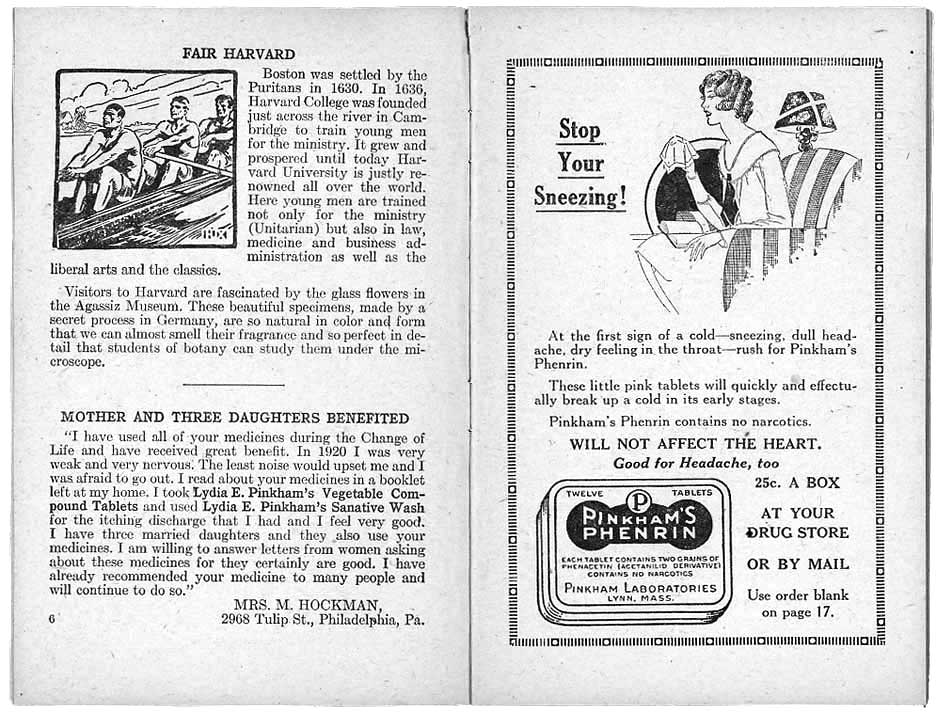YOUR remedies for menstrual period
pain and problems. See more remedies here.
A discussion of Pinkham letter testimonials,
and their authenticity, of the Pinkham company (in a discussion of a Pursettes
ad with a letter testimonial)
See two letters to MUM about the ingredients
of her Compound, and one about the lyrics of an English
pop song, Lily the Pink, about her.
Other amazing women: Nelli
Bly, Dr. Marie Stopes,
Dr. Grace Feder Thompson
Harry Finley created the images.
What did women do about menstruation
in the past?
 
|

MUSEUM OF MENSTRUATION AND WOMEN'S HEALTH
The Lydia E. Pinkham Medicine Co., maker of sanitary napkins, perfume,
brooches, medicine for headaches,
constipation, menopause, insomnia, depression, cancer, tumors, women's diseases,
colds,
flatulence, menstruation, fertility, douches, kidneys, mouth wash, liniment,
hemorrhoids, etc.
"Landmarks of New England" (U.S.A.,
1929)
Pamphlet for tourists. Guide to Boston, Provincetown, colleges, Pilgrims,
Salem, witches, Lynn, etc.
Below, P. 6:
It's interesting that scientific research
is missing from the associations with Harvard below but this was probably
because it was before science became the huge enterprise it is today - and
women in 1929 had little personal involvement in it.
About the astronomer Dr. Cecilia Payne-Gaposchkin
(from http://harvardmagazine.com/2002/03/portrait-of-a-pioneer.html):
In 1938 [9 years after this booklet] she was appointed Phillips astronomer
in the Harvard College Observatory without limit of time and lecturer on
astronomy, becoming the first woman to receive tenure
in the Faculty of Arts and Sciences (FAS) [at Harvard]. Eighteen
years later [1956] she was made professor of astronomy and chair of the
department, the first woman to chair a department
in FAS. Payne-Gaposchkin was also the first woman to be appointed
professor from within the Faculty of Arts and Sciences.
[and]
She earned the Ph.D. in 1925. Her doctoral thesis was judged by a senior
astronomer of her time to be the most brilliant ever
written in astronomy.
Instead of that, the text emphasizes glass flowers,
something that ladies would be sure to be interested in and, um, capable
of understanding.
|
Below, p. 7:
From Wikipedia:
Phenacetin [in Phenrin, below],
introduced in 1887, was used principally as an analgesic, and was one of
the first synthetic fever reducers to go on the market. It is also known
historically to be the first analgesic without anti-inflammatory properties.
Typical doses of 300mg to 500mg a day result in an analgesic effect. Recently,
its use as an analgesic has declined due to its association with several
adverse side effects, some of which are described following.
|
|
 |
© 2009 Harry Finley. It is illegal to reproduce or distribute any
of the work on this Web site
in any manner or medium without written permission of the author. Please
report suspected
violations to hfinley@mum.org\
|